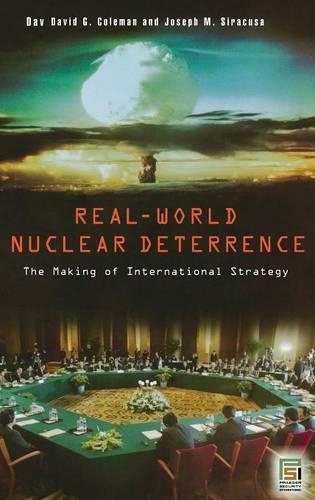
Real-World Nuclear Deterrence: The Making of International Strategy
(Hardback)
Publishing Details
Real-World Nuclear Deterrence: The Making of International Strategy
By (Author) David G. Coleman
By (author) Joseph M. Siracusa
Bloomsbury Publishing PLC
Praeger Publishers Inc
30th June 2006
United States
Classifications
General
Non Fiction
355.02
Physical Properties
Hardback
184
Description
The threat of nuclear weapons did not fade away with the collapse of the Soviet Union. Rather, the geopolitical disorders of the post-Cold War era and the rise of global terrorism have ensured that they remain conspicuously present on the world stage as a serious international concern. With the eight or nine nuclear powers maintaining about 27,000 nuclear weapons in their arsenals to this day, it is clear that they are here to stay for the foreseeable future. The primary mission of these nuclear forces has been and remains deterrence. Using plain language rather than policy jargon, this historically focused book shows how nuclear deterrence has worked rather than how it should. It then shows how the growing threat of nuclear proliferation threatens to create a far more complicated international situation largely because of the attendant proliferation of state nuclear deterrents. By drawing on a wide array of new sources from international archives and the latest in international scholarship, Coleman and Siracusa put some of the most important and enduring problems of nuclear deterrence over the past sixty years into global context. Nuclear deterrence in the real world often operates very differently from how it should according to the prevailing theories, and Coleman and Siracusa take a fresh look at how nuclear weapons policy has been made, finding that it often has had surprisingly little to do with what works and what does not. By studying in depth how governments here and abroad have confronted and dealt with some of the most important issues in nuclear weapons policy, for example, How many nuclear weapons are enough and What is it that will deter they find that the making of nuclear weapons policy is a complex, fluid bargaining process subject to the tides of politics, budgets, threat perception, ideology, technology, parochial service rivalries, flawed information, and sometimes just plain wishful thinking.
Reviews
David G. Coleman and Joseph M. Siracusa deliver a concise, readable, and thoughtful review of an exceedingly complex issue. In 121 pages of text they discuss the evolution of nuclear strategy in the United States, the Soviet Union, and other countries from the end of World War II to the present.[T]he book is a useful overview of an elusive and vitally important topic. * Journal of American History *
For Coleman and Siracusa the concept of nuclear deterrence is about more than preventing global thermonuclear war, it is about pursuing and protecting national interests and preventing limited conflicts and thus remains a topic of contemporary relevance, the end of the Cold War notwithstanding. Analyzing the history of nuclear deterrence policy, they discuss such topics as the inadequacy of the belief that the mere possession of nuclear weapons serves as a deterrent; US, British, and Soviet experiments with the concept of extended deterrence, in which nuclear guarantees are made to international allies; efforts to redress the overextension of the last concept with more credible deterrent forces; the question of how many nuclear weapons are enough; and the issue of controlling hostilities between nuclear-armed states. * Reference & Research Book News *
The book does a good job of taking the reader through the big (and largely Anglo-American) debates on nuclear policy--from containment, through massive retaliation and flexible response, and on to contemporary questions of proliferation.[t]he approach is fresh and lively. * Foreign Affairs *
Real-World Nuclear Deterrence: The Making of International Strategy follows the post-Cold War threat of nuclear weapons, surveying the major powers which maintain about 27,000 nuclear weapons to date, and using new sources from international archives and scholarship to consider the latest issues revolving around deterrence strategies. One might anticipate such a book would be geared towards military specialists, but an attention to clear language and historical references lends to lay reader understanding. * Midwest Book Review - Library Bookwatch *
Author Bio
David G. Coleman is an Assistant Professor at the University of Virginia's Miller Center of Public Affairs where he is Deputy Director of the Presidential Recordings Program. He is a specialist on nuclear history and international foreign policy and has written extensively on nuclear policy, U.S.-German relations, Cold War foreign policy, and John F. Kennedy. He is author (with Joseph M. Siracusa) of Depression to Cold War. Joseph M. Siracusa is a specialist in presidential politics, diplomacy, and security issues at the School of Global Studies, Social Science and Planning, RMIT University, Melbourne. He is internationally known for his writings on nuclear politics, American diplomacy, and modern U.S. history. Dr. Siracusa is also a frequent political affairs commentator in the Australian media, including ABC Radio National. Among his numerous books are A History of United States Foreign Policy: Depression to Cold War (with David G. Coleman), and Presidential Profiles: The Kennedy Years.
